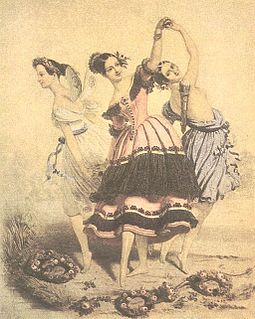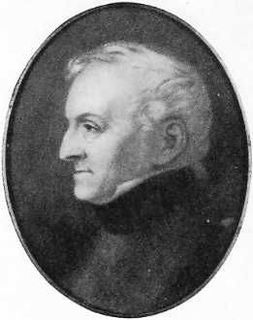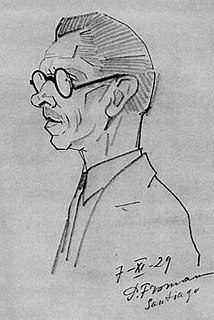La Fille du Danube (The Daughter of the Danube) is a ballet in two acts and four scenes, choreographed by Filippo Taglioni to music by Adolphe Adam.

La Fille du Danube (The Daughter of the Danube) is a ballet in two acts and four scenes, choreographed by Filippo Taglioni to music by Adolphe Adam.

La Fille du Danube was choreographed and produced by Filippo Taglioni for his daughter, Marie Taglioni, the creator of the titular role and was premièred on 21 September 1836 by the ballet of the Académie Royale de Musique, Paris. Like his 1832 ballet La Sylphide , La Fille du Danube focused on the romantic theme of a supernatural maiden, but with both inhibiting a different element - the Sylph is a maiden of the air, while the Daughter of the Danube is a maiden of the water.
The following year in 1837, Taglioni and his daughter travelled to St Petersburg, Russia where Marie Taglioni made her Russian debut in La Sylphide on the 6 September 1837 at the Imperial Bolshoi Kammeny Theatre. Her St Petersburg debut was a huge success, with the Russian balletomanes and critics becoming completely enchanted by the Italian ballerina. That same year, her father revived and restaged La Fille du Danube for Marie's benefit performance on the 20 December 1837 and the revival was a tremendous success. One critic wrote:
The ballet presented yesterday, La Fille du Danube, had a marvellous success. The balletmaster Mr Taglioni, the creator of the ballet, who produced it on our stage, was called for after the first and second acts. Mlle Taglioni was never so captivating as on this evening. The calls for her were endless; we lost count of them. [1]
Marie Taglioni performed in La Fille du Danube for the final time in St Petersburg in 1842, a week before her final performance in Russia.
La Fille du Danube was to be one of the two ballets by Filippo Taglioni to survive in Russia following the departures of both the balletmaster and his daughter from the country, the other being La Sylphide. In 1880, at the request of Tsar Alexander II, who had seen Marie Taglioni in the ballet, La Fille du Danube was revived by Marius Petipa for the Prima Ballerina, Ekaterina Vazem. For this revival, Petipa included new musical additions and revisions by Léon Minkus and the revival was premièred at the Imperial Bolshoi Kammeny Theatre on 24 February 1880 for Vazem's benefit performance. Vazem writes in her memoirs how she felt that the ballet was "flat", that the heroine's part was "not the most effective" and goes onto claim that "the mounting of the ballet looked quite wretched". However, she also writes that the premiere was met with much enthusiasm from the public:
For all the minuses of this production, however, the public, perhaps fascinated by the legend of the furore which Taglioni created in La Fille du Danube, came to the theatre in throngs. [2]

Marie Taglioni, Comtesse de Voisins was an Italian ballet dancer of the Romantic ballet era, a central figure in the history of European dance. She was one of the most celebrated ballerinas of the romantic ballet, which was cultivated primarily at Her Majesty's Theatre in London and at the Théâtre de l'Académie Royale de Musique of the Paris Opera Ballet. She is credited with being the first ballerina to truly dance en pointe.

The Romantic ballet is defined primarily by an era in ballet in which the ideas of Romanticism in art and literature influenced the creation of ballets. The era occurred during the early to mid 19th century primarily at the Théâtre de l'Académie Royale de Musique of the Paris Opera Ballet and Her Majesty's Theatre in London. It is typically considered to have begun with the 1827 début in Paris of the ballerina Marie Taglioni in the ballet La Sylphide, and to have reached its zenith with the premiere of the divertissement Pas de Quatre staged by the Ballet Master Jules Perrot in London in 1845. The Romantic ballet had no immediate end, but rather a slow decline. Arthur Saint-Léon's 1870 ballet Coppélia is considered to be the last work of the Romantic Ballet.
The Pharaoh's Daughter, is a ballet choreographed by Marius Petipa to music by Cesare Pugni. The libretto was a collaboration between Jules-Henri Vernoy de Saint-Georges and Petipa from Théophile Gautier's Le Roman de la momie. It was first presented by the Imperial Ballet at the Imperial Bolshoi Kamenny Theatre, in St. Petersburg, Russia, on 18 January 1862, with the design by A. Roller, G. Wagner (scenery), Kelwer and Stolyakov (costumes).
La Sylphide is a romantic ballet in two acts. There were two versions of the ballet; the original choreographed by Filippo Taglioni in 1832, and a second version choreographed by August Bournonville in 1836. Bournonville's is the only version known to have survived and is one of the world's oldest surviving ballets.

Marius Ivanovich Petipa, born Victor Marius Alphonse Petipa, was a French ballet dancer, pedagogue and choreographer. Petipa is one of the most influential ballet masters and choreographers in ballet history.

Filippo Taglioni was an Italian dancer and choreographer and personal teacher to his own daughter, Romantic ballerina Marie Taglioni. Also, although August Bournonville's version is better known, it was Taglioni who was the original choreographer of La Sylphide, in 1832.

Carlotta Grisi was an Italian ballet dancer. Born in Visinada, Istria, she was trained at the ballet school of Teatro alla Scala in Milan and later with dancer/balletmaster Jules Perrot. She was especially noted for her performance in the classic role of "Giselle".
La Fille mal gardée is a comic ballet presented in two acts, inspired by Pierre-Antoine Baudouin's 1765 painting, La réprimande/Une jeune fille querellée par sa mère. The ballet was originally choreographed by the Ballet Master Jean Dauberval to a pastiche of music based on fifty-five popular French airs. The ballet was premiered on 1 July 1789 at the Grand Théâtre de Bordeaux in Bordeaux, France under the title Le ballet de la paille, ou Il n'est qu'un pas du mal au bien.

Jules-Joseph Perrot was a dancer and choreographer who later became Ballet Master of the Imperial Ballet in St. Petersburg, Russia. He created some of the most famous ballets of the 19th century including Pas de Quatre, La Esmeralda, Ondine, and Giselle with Jean Coralli.

The Sergeyev Collection is a collection of choreographic notation, music, designs for décor and costumes, theatre programs, photos and other materials that document the repertory of the Imperial Ballet of St. Petersburg, Russia at the turn of the 20th century. The majority of the choreographic notations document with varying degrees of detail the original works and revivals of the renowned choreographer Marius Petipa, who served as Premier Maître de ballet of the St. Petersburg Imperial Theatres, as well as notation and music documenting the ballets of Lev Ivanov, who served as second Maître de ballet. Also included in the collection are choreographic notation documenting dances from various operas by both Petipa and Ivanov, respectively.
Pehr Christian Johansson was a teacher, choreographer and balletmaster for the Russian Imperial Ballet. He was engaged at the Royal Swedish Ballet in 1829-41, and at the Imperial Russian Ballet in 1841-66.

The Bandits is a grand ballet in two acts and five scenes with prologue, choreographed by Marius Petipa to music by Léon Minkus. The libretto by Marius Petipa is based on Miguel de Cervantes' novella La gitanilla.
The Daughter of the Snows is a fantastic ballet in three acts and five scenes, with choreography by Marius Petipa and music by Ludwig Minkus. The libretto by Marius Petipa is based on the play The Snow Maiden by Alexander Ostrovsky, inspired by a Russian folk fairy tale about Snegurochka from the folklore collection by Alexander Afanasyev.
Lydia, the Swiss Milkmaid is a Demi-Caractère ballet in 2 acts, with choreography by Filippo Taglioni and music by Adalbert Gyrowetz.
La Prima Ballerina, ou L'embuscade or The Traveling Dancer is a ballet in one act, with choreography by Marius Petipa, music by Cesare Pugni and libretto by Paul Taglioni. It was based on a ballet created by Paul Taglioni for the Ballet of Her Majesty's Theatre, London first presented on June 14, 1849.
Ekaterina Sankovskaya was a Russian dancer who graduated from the Moscow Bolshoi Ballet School in 1836. She was prima ballerina of the Moscow Imperial troupe.

Ludwig Minkus, also known as Léon Fyodorovich Minkus, was a Jewish-Austrian composer of ballet music, a violin virtuoso and teacher.

Yekaterina Ottovna Vazem aka Ekaterina Vazemwas a Russian prima ballerina and instructor, whose most noted pupil was the legendary Anna Pavlova.

Ekaterina Krysanova is a Russian principal dancer of Bolshoi Ballet.

La Forêt enchantée is a ballet fantastique in one act, originally choreographed by Lev Ivanov to the music of Riccardo Drigo, first presented by students of the Imperial Ballet School in St. Petersburg, Russia, at the school's theatre on 5 April [O.S. 24 March] 1887.